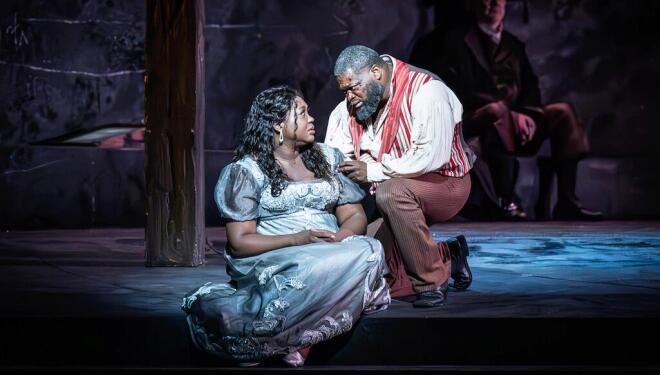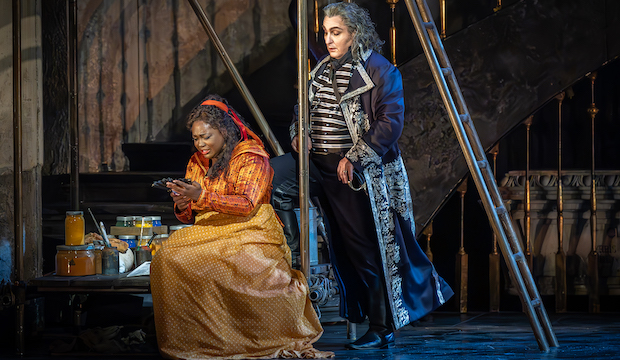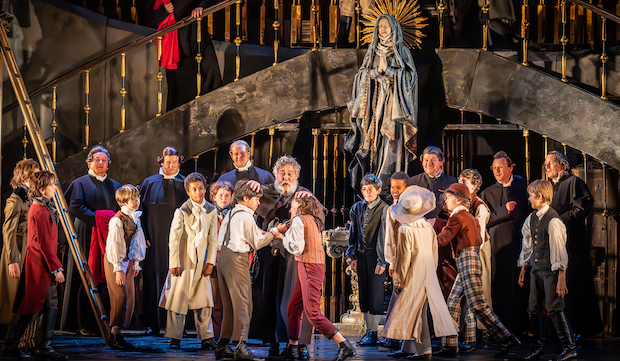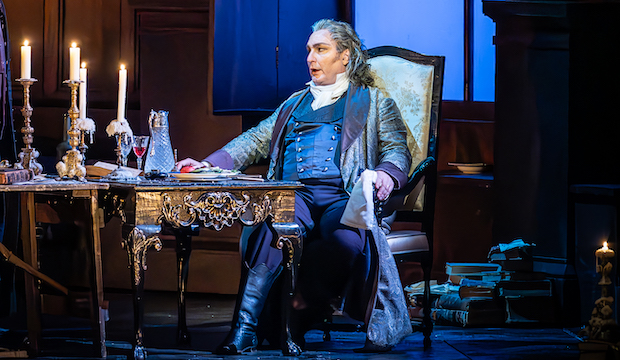
In Tosca, the heroine is indeed pursued by a repellant man and tormented by the torture of her politically active lover, but the body on the stage at the end of Act 2 is not hers.
I once stood in the wings at the Metropolitan Opera House in New York for the scene in which Tosca takes her chance and stabs the predatory Baron Scarpia, and believe me, you would not have wanted to be that baritone at that moment. 
Angel Blue as Tosca and Ludovic Tézier as Scarpia. Photo: Marc Brenner
At the Royal Opera House, it is the American soprano Angel Blue who lunges at French baritone Ludovic Tézier, with a passion for which even this bully-boy suitor is no match. This pivotal act is always the most thrilling of the three, and particularly in this new casting of Jonathan Kent's matchless production.
Act One opens somewhat sedately with American tenor Russell Thomas's painter Cavaradossi at work in the church of Sant'Andrea della Valle in Rome. Political uncertainty is in the air, as power swings to and from the rebels and Cavaradossi harbours an escaped prisoner (Christian Federici's elastic Angelotti).
Even the lively arrival of Angel Blue does not trigger much animation in Thomas, but lust floods over the audience with Scarpia's menacing appearance. Tézier is like a bird of prey, unblinking and with head turned or cocked, his target always in his sights. 
Jeremy White (centre) as the Sacristan, and the chorus and children's chorus. Photo: Marc Brenner
The anguish of captured Tosca, once cornered in the Palazzo Farnese, cuts through Puccini's surging waves of orchestral colour and her 'why me?' aria, Vissi d'arte, voiced the plight of all victims of tyranny.
Tosca is always in the top five most performed operas worldwide, and the attention to detail in this peerless production shows why. Yes, there are the three strong central characters, but also vignettes in the score that, thanks to Kent's direction, the late Paul Brown's atmospheric and monumental design and Mark Henderson's lighting give depth and texture to the drama.
Take the shepherd boy's ethereal dawn song, the magical off-stage music as day breaks over Castel Sant'Angelo, where Cavarodossi has been imprisoned, morning mass bells ringing across the city. It's a moment of pure artistic generosity. The plot doesn't need it, but it points up the sweetness of life, even as it hangs by a thread.
Ludovic Tézier's predatory Scarpia. Photo: Marc Brenner
One of three youngsters in this role, Tharuni Kalavannan sang this with innocent charm, a spellbinding counterweight to Cavaradossi's knowing anthem to the starry sky and to life itself, 'E lucevan le stelle' .
Andrea Battistoni, conducting, took his time in Act One, as did his on-stage lovers, but in Act Two the tide positively raced in and the Orchestra of the Royal Opera House was on tip-top form, the characterful bassoon a particular thrill.
It's impossible to tire of this opera, and of this timeless production. And just look what happens when people wreak revenge on those in power...
Tosca is sung in Italian with English surtitles. Further performances are on 5, 8, 11, 13, 14 (matinee), 16, 17, 19, 21 (matinee) July. Click here to book
| What | Tosca, Royal Opera House review |
| Where | Royal Opera House, Bow Street, Covent Garden, London, WC2E 9DD | MAP |
| Nearest tube | Covent Garden (underground) |
| Price | £13-£270 |
| Website | Click here for details and booking |
